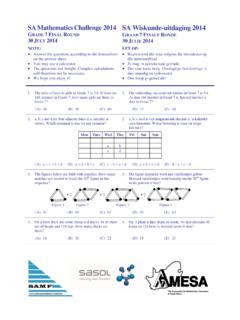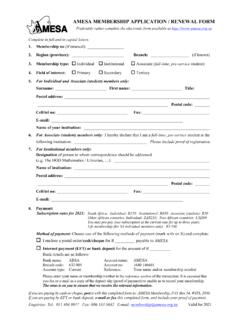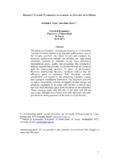Transcription of Can Multiple Choice Questions be Successfully Used as an ...
1 Can Multiple Choice Questions be Successfully Used as an Assessment Format in Undergraduate Mathematics? Belinda Huntley; Johann Engelbrecht; Ansie Harding University of Pretoria In this study we propose a taxonomy for assessment in mathematics, which we call the assessment component taxonomy, to identify those components of mathematics that can be Successfully assessed using alternative assessment formats. Based on the literature on assessment models and taxonomies in mathematics, this taxonomy consists of seven mathematics assessment components, hierarchically ordered by cognitive level, as well as the nature of the mathematical tasks associated with each component. Using a model that we developed earlier for measuring the quality of mathematics test items, we investigate which of the assessment components can be Successfully assessed in the provided response question (PRQ) format, in particular Multiple Choice Questions (MCQs), and which can be better assessed in the constructed response question (CRQ) format.
2 The results of this study show that MCQs can be constructed to evaluate higher order levels of thinking and learning. The conclusion is that MCQs can be Successfully used as an assessment format in undergraduate mathematics, more so in some assessment components than in others. The inclusion of the PRQ assessment format in all seven assessment components can reduce the large marking loads, associated with continuous assessment practices in undergraduate mathematics, without compromising the validity of the assessment. In South Africa, as in the rest of the world, the changes in society and technology have imposed pressures on academics to review current assessment approaches. Changes in education assessment are currently being called for, both within the fields of measurement and evaluation as well as in specific academic disciplines such as mathematics. Geyser (2004) summarises the paradigm shift that is currently under way in tertiary education as follows: The main shift in focus can be summarized as a shift away from assessment as an add-on experience at the end of learning, to assessment that encourages and supports deep learning.
3 It is now important to distinguish between learning for assessment and learning from assessment as two complementary purposes of assessment. (p. 90). Mathematics at tertiary level remains conservative in its use of alternative formats of assessment. As goals for mathematics education change to broader and more ambitious objectives (NCTM, 1989), such as developing mathematical thinkers who can apply their knowledge to solving real problems, a mismatch is revealed between traditional assessment and the desired student outcomes. It is no longer appropriate to assess student mathematical knowledge using general assessment taxonomies, because these taxonomies are not pertinent to mathematics and do not identify those levels of mathematics that can be assessed using alternative formats of assessment. With this background, we propose a taxonomy of mathematics, which we call the assessment component taxonomy, to identify those components of mathematics that can be Successfully assessed using alternative assessment formats.
4 Using a model that we developed earlier (Huntley, Engelbrecht &. Pythagoras, 69, 3-16 (July 2009) 3. MCQ in undergraduate mathematics Harding, 2008; 2009) for measuring the quality of mathematical test items, we investigate which of the assessment components can be Successfully assessed in the provided response question (PRQ) format, in particular Multiple Choice Questions (MCQs), and which can be better assessed in the constructed response question (CRQ) format where students have to construct and supply their own responses (Engelbrecht & Harding, 2003). Mathematics assessment models An assessment model emerges from the different aspects of assessment: what we want to have happen to students in a mathematics course, different methods and purposes for assessment, along with some additional dimensions. The first dimension of this framework is what to assess, which may be broken down into: concepts, skills, applications, attitudes and beliefs. Niss (1993) uses the term assessment mode to indicate a set of items in an assessment model that could be implemented in mathematics education.
5 These items include the following: o The subject of assessment, who is assessed o The objects of assessment, what is assessed o The items of assessment, what kinds of output are assessed o The occasions of assessment, when does assessment take place o The procedures and circumstances of assessment, what happens, and who is expected to do what o The judging and recording in assessment, what is emphasised and what is recorded o The reporting of assessment outcomes, what is reported, to whom. For the purpose of this study, the focus will be on the objects of assessment in the Niss model outlined above, types of mathematical content (including methods, internal and external relations) and which types of student ability to deal with that content. This varies greatly with the place, the teaching level and the curriculum, but the predominant content objects assessed seem to be the following: (a) Mathematical facts, which include definitions, theorems, formulae, certain specific proofs and historical and biographical data.
6 (b) Standard methods and techniques for obtaining mathematical results. These include qualitative or quantitative conclusions, solutions to problems and display of results. (c) Standard applications which include familiar, characteristic types of mathematical situations which can be treated by using well-defined mathematical tools. To a lesser extent, objects of assessment also include: (d) Heuristic and methods of proof as ways of generating mathematical results in non-routine contexts. (e) Problem solving of non-familiar, open-ended, complex problems. (f) Modelling of open-ended, real mathematical situations belonging to other subjects, using whatever mathematical tools at one's disposal. In mathematics, we rarely encounter (g) Exploration and hypothesis generation as objects of assessment. With regards to the students' ability to be assessed, the first three content objects require knowledge of facts, mastery of standard methods and techniques and performance of standard applications of mathematics, all in typical, familiar situations.
7 As we proceed towards the content objects in the higher levels of the Niss assessment model, the level of the students' abilities to be assessed also increase in terms of cognitive difficulty. In the proof, problem- solving, modelling and hypothesis objects, students are assessed according to their abilities to activate or even create methods of proof; to solve open-ended, complex problems; to perform mathematical modelling of open-ended real situations and to explore situations and generate hypotheses. In the Niss assessment model, objects (a) (g) and the corresponding students' abilities are widely considered to be essential representations of what mathematics and mathematical activity are really about. The first three objects in the list emphasise routine, low-level features of mathematical work, whereas the 4. Belinda Huntley, Johann Engelbrecht & Ansie Harding remaining objects are cognitively more demanding. Objects (a), (b) and (c) are fundamental instances of mathematical knowledge, insight and capability.
8 Current assessment models in mathematics education are often restricted to dealing only with these first three objects. One of the reasons for this is that methods of assessment for assessing objects (a), (b) and (c) are easier to devise. In addition, the traditional assessment methods meet the requirement of validity and reliability in that there is no room for different assessors to seriously disagree on the judgement of a product or process performed by a given student. It is far more difficult to devise tools for assessing objects (d) (g). Inclusion of these higher- level objects into assessment models would bring new dimensions of validity into the assessment of mathematics. Webb and Romberg (1992) argue that if we assess only objects (a), (b) and (c) and continue to leave objects (d) (g) outside the scope of assessment, we not only restrict ourselves to assessing a limited set of aspects of mathematics, but also contribute to actually creating a distorted and wrong impression of what mathematics really is (Niss, 1993).
9 Assessment taxonomies According to the World Book Dictionary (1990), a taxonomy is any classification or arrangement. Taxonomies are used to ensure that examinations contain a mix of Questions to test skills and concepts. A. leader in the use of a taxonomy for test construction and standardization was Ralph W. Tyler, the father of educational evaluation (Romberg, 1992, p. 19) who in 1931 reported on his efforts to construct achievement tests for various university courses. The next step was taken by Benjamin Bloom (1956), who organised the objectives into a taxonomy (dedicated to Tyler) that attempted to reflect the distinctions teachers make and to fit all school subjects. In Bloom's Taxonomy of educational objectives, objectives were separated by domain (cognitive, affective and psychomotor), related to educational behaviours, and arranged in hierarchical order from simple to complex. Bloom's taxonomy has often been seen as fitting mathematics especially poorly (Romberg, Zarinnia &. Collis, 1990).
10 It is quite good for structuring assessment tasks, but Freeman and Lewis (1998) suggest that Bloom's taxonomy is not helpful in identifying which levels of learning are involved. As Ormell (1974) noted in a strong critique of the taxonomy, Bloom's categories of behaviour are extremely amorphous in relation to mathematics. They cut across the natural grain of the subject, and to try to implement them at least at the level of the upper school is a continuous exercise in arbitrary Choice (p. 7). Since its publication, variants of Bloom's taxonomy for the cognitive domain have helped provide frameworks for the construction and analysis of many mathematics achievement tests (Begle & Wilson, 1970; Romberg et al., 1990). Attacking behaviourism as the bane of school mathematics, Eisenberg (1975) criticised the merit of a task-analysis approach to curricula, because it essentially equates training with education, missing the heart and essence of mathematics. Expressing concern over the validity of learning hierarchies, he argued for a re-evaluation of the objectives of school mathematics.














